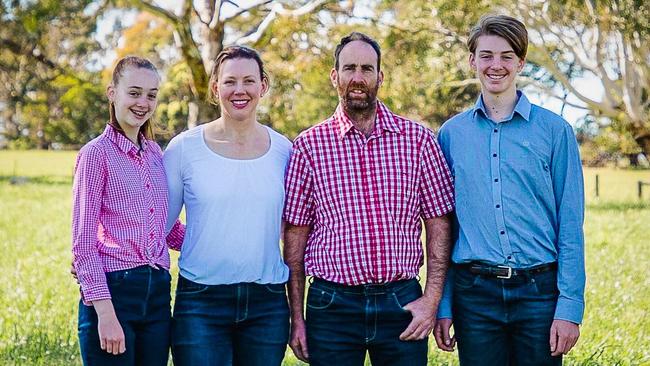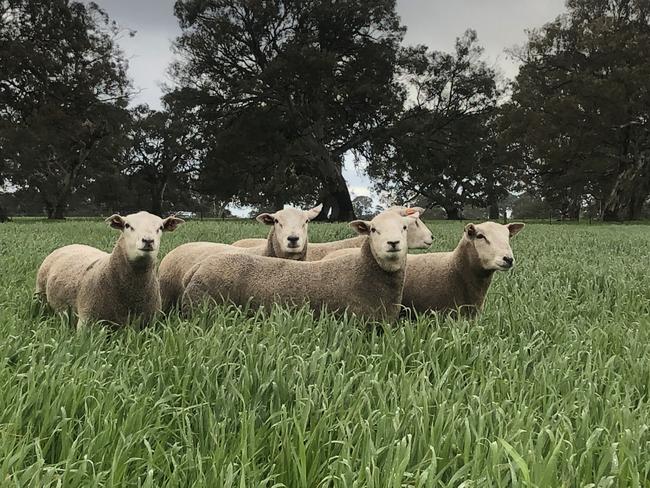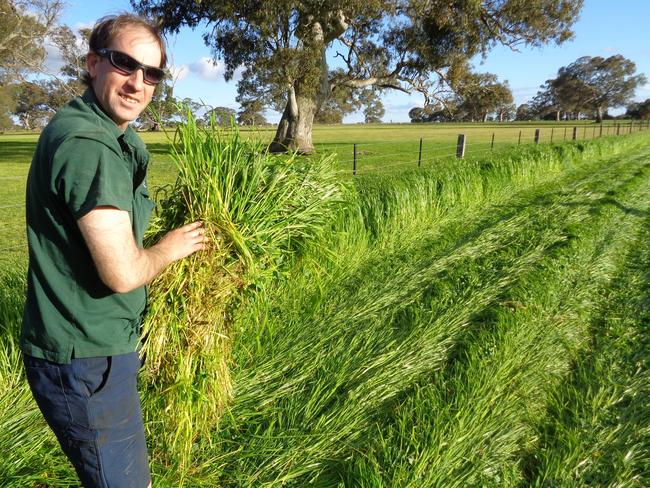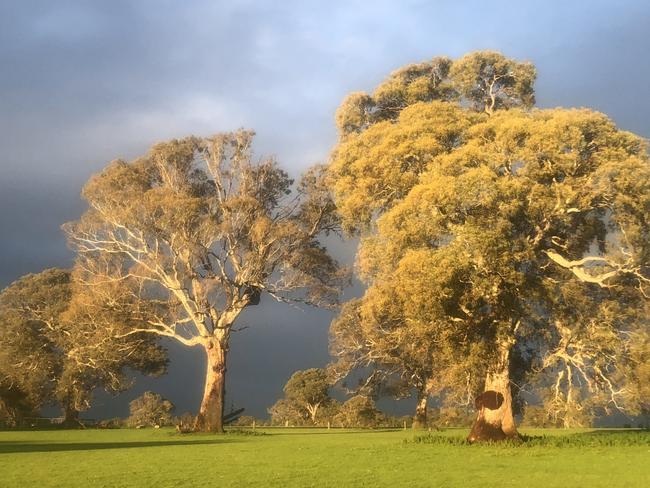Raising sheep production, reducing eco damage at Summit Park
The Parker family has made minimising their impact on the environment a priority on their Western District sheep farm without compromising production.

Increasing efficiency while reducing their environmental footprint has been a key component of Chris and Tania Parker’s Summit Park Enterprises since they bought their 80ha property at Hamilton 14 years ago.
Strategic work in sustainability, quality assurance and production has rewarded their stud sheep business with improved animal health and welfare, better soils and a robust farm ecology, including a thriving stand of over 600-year-old Red Gums that provide valuable protection for stock in paddocks.
“We’ve double fenced and revegetated our boundaries with neighbours, fenced out our waterways and dams, and are looking a lot more into soil health and sustainable land and soil management practices,” Tania said.
“We direct drill pastures rather than ploughing and are trying to increase the amount of organic matter in our soil.
“Everything starts with the soil so we need to look after it.”
TRIPLE THE OPTION
The Parkers run three lines of stud sheep – White Suffolks, Texels and Maternals, selling 80 rams a year, as well as prime lambs.
They have 300 breeding ewes across the studs and also operate a sheep scanning business with clients across southeastern Australia.
Chris is an accredited LambPlan scanner and has a passion for sheep breeding and genetics – his family were among the first breeders to purchase Texel embryos in Australia.
Their breeding philosophy continues to focus on performance and structural integrity.
All animals are performance recorded with LambPlan figures and their rams consistently have leading traits in the top 5 per cent of animals in Australia listed in Sheep Genetics.
“We have put a lot of time and finance into getting the property running effectively and efficiently too,” Chris said.
“From laneway systems, water supply, land class fencing and pasture renovation, we’re now seeing the benefits of all the hard work put in during the early years here at Summit Park.
“We now have 19 paddocks across the farm, all accessed via laneways, undercover sheep yards and a double fenced property boundary with well-established trees for biosecurity.”

MEAT AND WOOL
The Parkers operate a high input, high output system with a carrying capacity of 20 dry sheep equivalents per hectare.
Ewes are joined in March with a selection of artificial insemination, embryo transfer and natural joining. Lambing is in late winter, early spring onto green pastures for anticipated growth as the weather warms up in spring.
“Unfortunately we haven’t seen this for the past two years,” Tania said.
“The current season looks like it’s going to be about as tough as last summer.”
Average rainfall is well down – 448mm for 2024 compared to 650mm normally.
“We were lucky to get some hay and silage completed from the short growing season and rainfall we had in July but then it all dried up again,” Chris said.
Rainfall is normally winter-spring for their main growth period.
Shearing is conducted in spring and weaning is at three- to four-months-old depending on seasonal conditions. About 200 lambs from another lease block are sold each year direct to meatworks averaging 22kg to 24kg carcass weight.
“Lambs go straight to the supplier where possible so we get direct feedback and retain more control of our financial position in the market,” Tania said, adding there was a lot of data that went into breeding sheep.
“Both visual and genetic information is used in the studs, and anything that doesn’t make the stud becomes a commercial sheep.”
Stud selection and inclusion is decided at the beginning of each year.
“Wool is now fast becoming a secondary product, the carcass and meat is where the main value lies,” Chris said.
“We want to keep the wool as a sustainable product. With shearing costs, economically we need to keep the value in wool so we are trying to maintain carcass productivity with wool value.”
BETTER SOILS
The Summit Park property includes 8ha of vegetation and frontage to the Wannon River as well as a landlocked area that has never been sown or fertilised which has native grasses, orchids and lilies.
Soils are mostly sandy loam but vary across the property with some areas gravel, very sandy or containing small superficial rock and stone.
“We have put a lot of time, thought, effort and finance into our pastures and try to run stock on combined green feed for as long as the season will allow,” Chris said.
“We have several pastures with perennial species so we oversow when needed rather than spraying and ploughing, using best management practices.”
When they first bought the property, the soil was low in fertility and presented nutritional challenges for stock so the Parkers applied traditional synthetic based fertilisers such as MAP, DAP and single super.
Initial analysis of the soils showed a high phosphorus buffering index, meaning that there were factors limiting the availability of phosphorus in the soil to plants.
Agronomy recommendations were to apply extremely high levels of fertiliser to combat this, which was both costly and inefficient.
EFFICIENT FERTILISER
Local farming contractor and friend Wayne Vearing introduced Chris and Tania to a speciality liquid fertiliser from ECTOL after success on his own farm.
“Wayne dropped a 20L drum of NitrotainTE22 at the front gate, so we filled the boom spray and went for it, completing a test ring around a few paddocks,” Chris said.
“Within three days all the sheep were grazing on the ring where we had sprayed. It was obvious there was palatability and a preference for this nutritional input.”
The Parkers described this moment as their first real opportunity to think innovatively and start to transition away from chemical inputs on the farm.
“Our mixed pastures included oats, clover, plantain, rye-grass chicory and mixed hay crops to name a few,” Chris said.
“The aim was to increase pasture growth, and diversity by unlocking nutrition and making it more available to the plants. It seemed that ECTOL could help us to do this.
“Speaking with our agronomist at the time about nitrogen, we broke down the application of granule urea and liquid urea against ECTOL’s NitrotainTE22.
“She agreed, even a small application of three to four litres per hectare of NTE22 would deliver the required nitrogen, along with the added benefits of trace elements, and a product that is more plant-available.”
The current formulation of NitrotainTE27 is a liquid fertiliser providing 27 per cent total nitrogen that is fully utilised. It is formulated to retain nitrogen in the plant or soil, minimising atmospheric and leaching loss and the acidification of soils.

RAISING RESILIENCE
The Parkers have significantly pulled back their use of conventional fertiliser while still achieving strong pasture growth.
Insecticide use has also dramatically reduced, which Chris and Tania put down to using the nutritional inputs designed to support natural farming systems.
“Our plants and pastures are less attractive to insects so we have less need for insecticide,” Chris said.
“And on occasion, if insects are present, we notice the plants are more resilient. The balance seems to have changed and it is these little observations that make a significant difference to our operation.”
Chris and Tania have also introduced bio-stimulant products and mineral nutrition with elevated micro nutrients, compost and manure products, and found success with ECTOL’s certified organic guano and phosta k products to supplement other applications of chemicals for phosphorus and potassium.

ADDED BONUS
Since the reduction in the use of chemical fertilisers, the Parkers have noticed a positive flow-on effect to the health of their animals.
Their sheep are well indexed and require less vaccines and drenching. WEC markers are also consistently low.
Tania believes the health of the red gum trees on their property is also due to their commitment to sustainable land management.
“A ram client of ours recently noted the poor health of his red gum trees, with some dying off completely,” Tania said.
“He felt this was connected to a history of fertiliser application and chemical use on-farm.
“In the grand scheme of things our opportunity to farm on this land is really quite short but the footprint we choose to leave will last well beyond our time.
“We are just the current custodians doing the best we can to look after our land.
“It is our intention to look after the land on which we live to the best of our ability and show others what can be done with some innovative land management, including the use of more natural inputs.”




